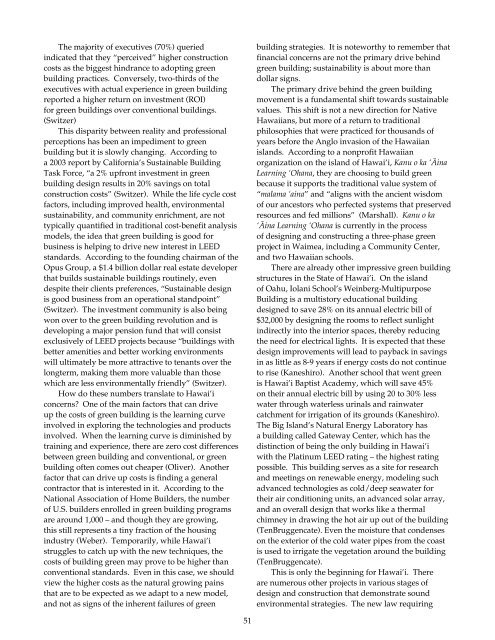A JOURNAL OF ACADEMIC WRITING VOLUME 5
A JOURNAL OF ACADEMIC WRITING VOLUME 5
A JOURNAL OF ACADEMIC WRITING VOLUME 5
You also want an ePaper? Increase the reach of your titles
YUMPU automatically turns print PDFs into web optimized ePapers that Google loves.
The majority of executives (70%) queried<br />
indicated that they “perceived” higher construction<br />
costs as the biggest hindrance to adopting green<br />
building practices. Conversely, two-thirds of the<br />
executives with actual experience in green building<br />
reported a higher return on investment (ROI)<br />
for green buildings over conventional buildings.<br />
(Switzer)<br />
This disparity between reality and professional<br />
perceptions has been an impediment to green<br />
building but it is slowly changing. According to<br />
a 2003 report by California’s Sustainable Building<br />
Task Force, “a 2% upfront investment in green<br />
building design results in 20% savings on total<br />
construction costs” (Switzer). While the life cycle cost<br />
factors, including improved health, environmental<br />
sustainability, and community enrichment, are not<br />
typically quantified in traditional cost-benefit analysis<br />
models, the idea that green building is good for<br />
business is helping to drive new interest in LEED<br />
standards. According to the founding chairman of the<br />
Opus Group, a $1.4 billion dollar real estate developer<br />
that builds sustainable buildings routinely, even<br />
despite their clients preferences, “Sustainable design<br />
is good business from an operational standpoint”<br />
(Switzer). The investment community is also being<br />
won over to the green building revolution and is<br />
developing a major pension fund that will consist<br />
exclusively of LEED projects because “buildings with<br />
better amenities and better working environments<br />
will ultimately be more attractive to tenants over the<br />
longterm, making them more valuable than those<br />
which are less environmentally friendly” (Switzer).<br />
How do these numbers translate to Hawai’i<br />
concerns? One of the main factors that can drive<br />
up the costs of green building is the learning curve<br />
involved in exploring the technologies and products<br />
involved. When the learning curve is diminished by<br />
training and experience, there are zero cost differences<br />
between green building and conventional, or green<br />
building often comes out cheaper (Oliver). Another<br />
factor that can drive up costs is finding a general<br />
contractor that is interested in it. According to the<br />
National Association of Home Builders, the number<br />
of U.S. builders enrolled in green building programs<br />
are around 1,000 – and though they are growing,<br />
this still represents a tiny fraction of the housing<br />
industry (Weber). Temporarily, while Hawai’i<br />
struggles to catch up with the new techniques, the<br />
costs of building green may prove to be higher than<br />
conventional standards. Even in this case, we should<br />
view the higher costs as the natural growing pains<br />
that are to be expected as we adapt to a new model,<br />
and not as signs of the inherent failures of green<br />
51<br />
building strategies. It is noteworthy to remember that<br />
financial concerns are not the primary drive behind<br />
green building; sustainability is about more than<br />
dollar signs.<br />
The primary drive behind the green building<br />
movement is a fundamental shift towards sustainable<br />
values. This shift is not a new direction for Native<br />
Hawaiians, but more of a return to traditional<br />
philosophies that were practiced for thousands of<br />
years before the Anglo invasion of the Hawaiian<br />
islands. According to a nonprofit Hawaiian<br />
organization on the island of Hawai’i, Kanu o ka ‘Äina<br />
Learning ‘Ohana, they are choosing to build green<br />
because it supports the traditional value system of<br />
“malama ‘aina” and “aligns with the ancient wisdom<br />
of our ancestors who perfected systems that preserved<br />
resources and fed millions” (Marshall). Kanu o ka<br />
‘Äina Learning ‘Ohana is currently in the process<br />
of designing and constructing a three-phase green<br />
project in Waimea, including a Community Center,<br />
and two Hawaiian schools.<br />
There are already other impressive green building<br />
structures in the State of Hawai’i. On the island<br />
of Oahu, Iolani School’s Weinberg-Multipurpose<br />
Building is a multistory educational building<br />
designed to save 28% on its annual electric bill of<br />
$32,000 by designing the rooms to reflect sunlight<br />
indirectly into the interior spaces, thereby reducing<br />
the need for electrical lights. It is expected that these<br />
design improvements will lead to payback in savings<br />
in as little as 8-9 years if energy costs do not continue<br />
to rise (Kaneshiro). Another school that went green<br />
is Hawai’i Baptist Academy, which will save 45%<br />
on their annual electric bill by using 20 to 30% less<br />
water through waterless urinals and rainwater<br />
catchment for irrigation of its grounds (Kaneshiro).<br />
The Big Island’s Natural Energy Laboratory has<br />
a building called Gateway Center, which has the<br />
distinction of being the only building in Hawai’i<br />
with the Platinum LEED rating – the highest rating<br />
possible. This building serves as a site for research<br />
and meetings on renewable energy, modeling such<br />
advanced technologies as cold/deep seawater for<br />
their air conditioning units, an advanced solar array,<br />
and an overall design that works like a thermal<br />
chimney in drawing the hot air up out of the building<br />
(TenBruggencate). Even the moisture that condenses<br />
on the exterior of the cold water pipes from the coast<br />
is used to irrigate the vegetation around the building<br />
(TenBruggencate).<br />
This is only the beginning for Hawai’i. There<br />
are numerous other projects in various stages of<br />
design and construction that demonstrate sound<br />
environmental strategies. The new law requiring
















